Have you ever wondered, “Do tree removal companies work in the rain?” It’s a common question that arises, as working with trees in the rain can pose significant challenges. In this blog post, we will unveil the truth behind wet weather tree removal, discussing how these professionals adapt to the rainy season, assess risks associated with tree removal in the rain, and how they ensure the safety of both workers and clients.
Key Takeaways
• Tree removal companies take necessary safety precautions to ensure the safety of their workers and clients in rainy conditions.
• Removal should be postponed in cases of heavy rain or high wind, and an assessment of weather conditions is required to evaluate risk.
• Tree surgeons can adapt by implementing flexible scheduling & focusing on indoor tasks such as project assessment & preparation.
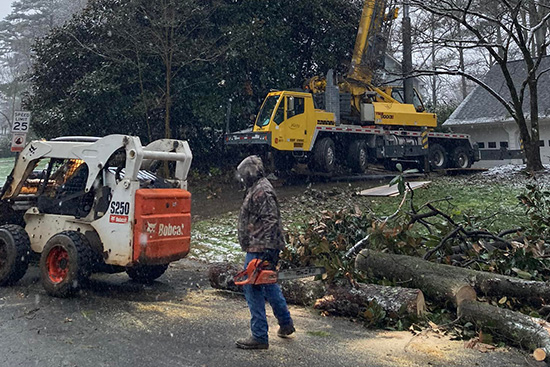
Weather Factors Affecting Tree Removal
Weather conditions can significantly impact tree removal, particularly when dealing with light rain and wet ground. Arborists often face slippery surfaces, falling branches, and electrical hazards when working on a wet tree in the rain. Equipping arborists and tree professionals with proper safety gear and adhering to best practices is necessary for ensuring their safety and the efficiency of the job when working in wet weather.
Light Rain vs. Heavy Rain
When it’s raining lightly, it can create hazardous conditions for tree removal by increasing slipperiness and mud. This makes cutting and removing trees more challenging as branches and trunks become slippery and difficult to handle. While arborists can take necessary precautions with the right gear and equipment, heavy rain and bad weather can present severe risks.
The saturated and soft soil due to heavy rain can weaken the tree’s root system, making it more difficult to safely remove the tree without causing damage or instability. Therefore, using appropriate safety gear is vital, and tree removal should be postponed during heavy rain.
Wet Ground Dangers
Wet ground can pose several safety risks during tree removal operations, such as increased risk of slipping and falling, decreased equipment stability, weakened tree stability, and limited traction. Waterlogged soil can lead to poor aeration, soil instability, and increased susceptibility to damage, all of which can complicate the tree removal process. Extra caution is necessary when removing a tree from waterlogged soil.
Tree Removal Safety Measures in Rainy Conditions
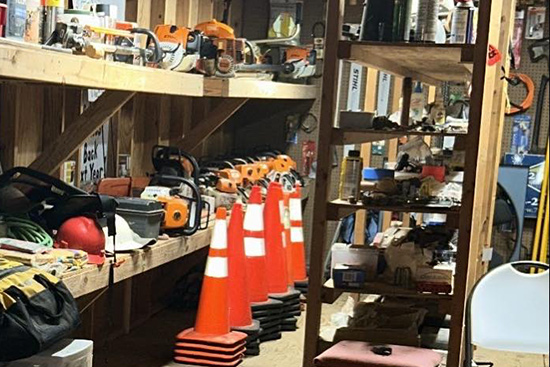
Tree removal companies take various safety measures to ensure the well-being of their workers and customers in rainy conditions. These measures include using the proper gear, following best practices, and, most importantly, knowing when to postpone the tree removal due to rain.
Proper Gear for Wet Weather
The need for appropriate rain gear for tree removal workers is highly emphasized. Waterproof jackets, pants, and boots are essential for helping arborists stay dry and protected during the tree removal process. Additionally, proper climbing helmets and gloves with enhanced grip are crucial for ensuring the safety of workers in wet and slippery conditions.
Best Practices for Rainy Day Tree Removal
Adhering to best practices can minimize risks during tree removal in rainy conditions. Some of these practices include using manual tools, such as loppers, hand-held shears, and pole pruners, which provide better control and precision in wet conditions.
There are times when hiring tree services is unwise and risky. Avoiding tree removal during heavy rain, thunderstorms, or high winds is also vital for the safety of workers and customers. By following these best practices, tree removal professionals can effectively manage the challenges posed by rainy days.
When To Postpone Tree Removal Due To Rain
The decision to postpone tree removal due to rain depends on various factors, such as risk assessment and client communication. Mild weather conditions with minimal rain and no wind are necessary for the safe performance of tree removal.
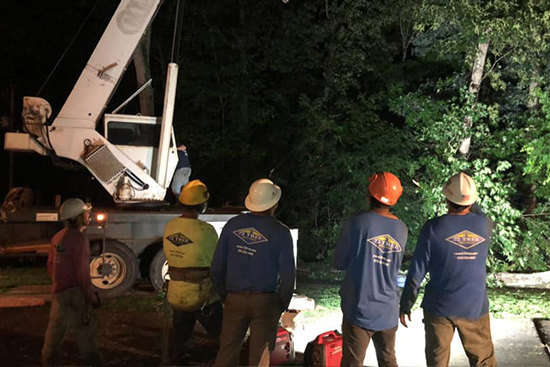
Assessing the Risk
Evaluating the risk of tree removal in rainy conditions involves assessing weather conditions, ground stability, and potential hazards. Strong or gusty winds, ice storms, or hazardous weather conditions, such as heavy rain or lightning, can indicate potentially hazardous conditions for tree removal.
Additionally, rain can affect ground stability, as it can saturate the soil, weaken the tree root system, and increase the risk of toppling.
Rescheduling and Communication with Clients
Tree removal companies should maintain open communication with clients regarding potential delays due to rain and reschedule appointments as needed. Tree removal companies can uphold customer satisfaction and trust by promptly communicating and providing alternative times or dates for the service. Clear communication is a key aspect of managing tree removal during rainy seasons.
How Tree Removal Companies Adapt to Rainy Season Challenges

Implementing flexible scheduling and focusing on indoor tasks can help tree removal companies adapt to rainy season challenges. This allows them to maintain productivity and ensure the safety of their workers and clients despite the challenges posed by wet conditions.
Flexible Scheduling
Implementing flexible scheduling strategies, such as leaving open days for rescheduling or offering multiple-day service windows, is one way to adapt to rainy season challenges. This can help companies adjust to weather conditions, reschedule jobs that cannot be safely completed in the rain, and prioritize tasks that can still be done in wet weather.
Indoor Tasks and Training
To maintain productivity during rainy days, tree removal workers can focus on indoor tasks, such as:
• Assessing and planning the tree removal project
• Reviewing safety protocols and equipment maintenance
• Conducting administrative tasks
• Providing customer service
• Training staff on the plan and safety procedures
By focusing on these tasks and continuing to cut trees, tree removal companies, also known as tree surgeons, can ensure that their operations continue smoothly during rainy seasons.
Case Study: Successful Tree Removal in Rainy Conditions
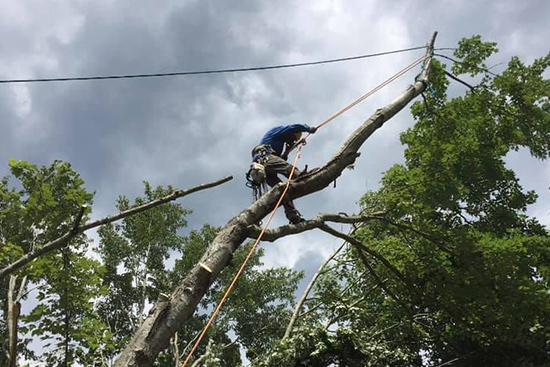
The photo above highlights a successful tree removal project that was carried out in rainy conditions. The tree removal company prioritized safety, utilized specialized equipment and tools, and employed strategic tree-cutting techniques to ensure the project’s success.
Despite the challenging weather conditions, the company completed the tree removal safely and efficiently, showcasing the importance of adaptability and following safety measures in rainy conditions.
Summary
In conclusion, tree removal companies face various challenges when working in wet weather conditions. However, by implementing proper safety measures, following best practices, and adapting to rainy season challenges, tree professionals can continue to provide services safely and efficiently. By understanding the risks and taking appropriate precautions, tree removal companies can successfully tackle wet weather removal projects, ensuring the safety of their workers, customers, and the environment.
Frequently Asked Questions
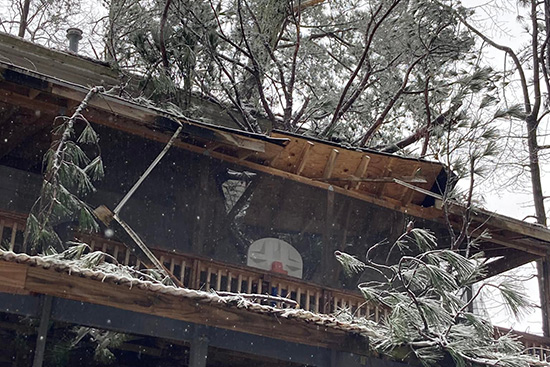
Can I cut a tree down in the rain?
Cutting a tree down in the rain is not usually advisable due to stormy, windy, or rainy conditions. The best weather for tree removal is a sunny or overcast calm day, so it’s recommended to reschedule if these conditions are not met.
What happens to trees when it rains too much?
Heavy rain can deprive trees of oxygen and weaken their root systems, leading to stress and susceptibility to ailments like fungi and pests. This can ultimately cause them to topple over during storms.
Can you trim a wet tree?
It is not advisable to prune a wet tree as the dampness can encourage bacteria growth. Pruning should be done in dry weather instead, with the exception of dead or damaged branches that require immediate removal.
What are the cons of taking down trees?
Destroying trees has serious environmental consequences, such as climate change, desertification, soil erosion, flooding, and increased greenhouse gases.
When should tree removal be postponed due to rain?
Tree removal should be postponed when there is heavy or severe rainfall, as mild weather conditions with minimal rain and no wind are necessary for safe tree removal.
This article was first published on: https://www.72tree.com/do-tree-removal-companies-work-in-the-rain/